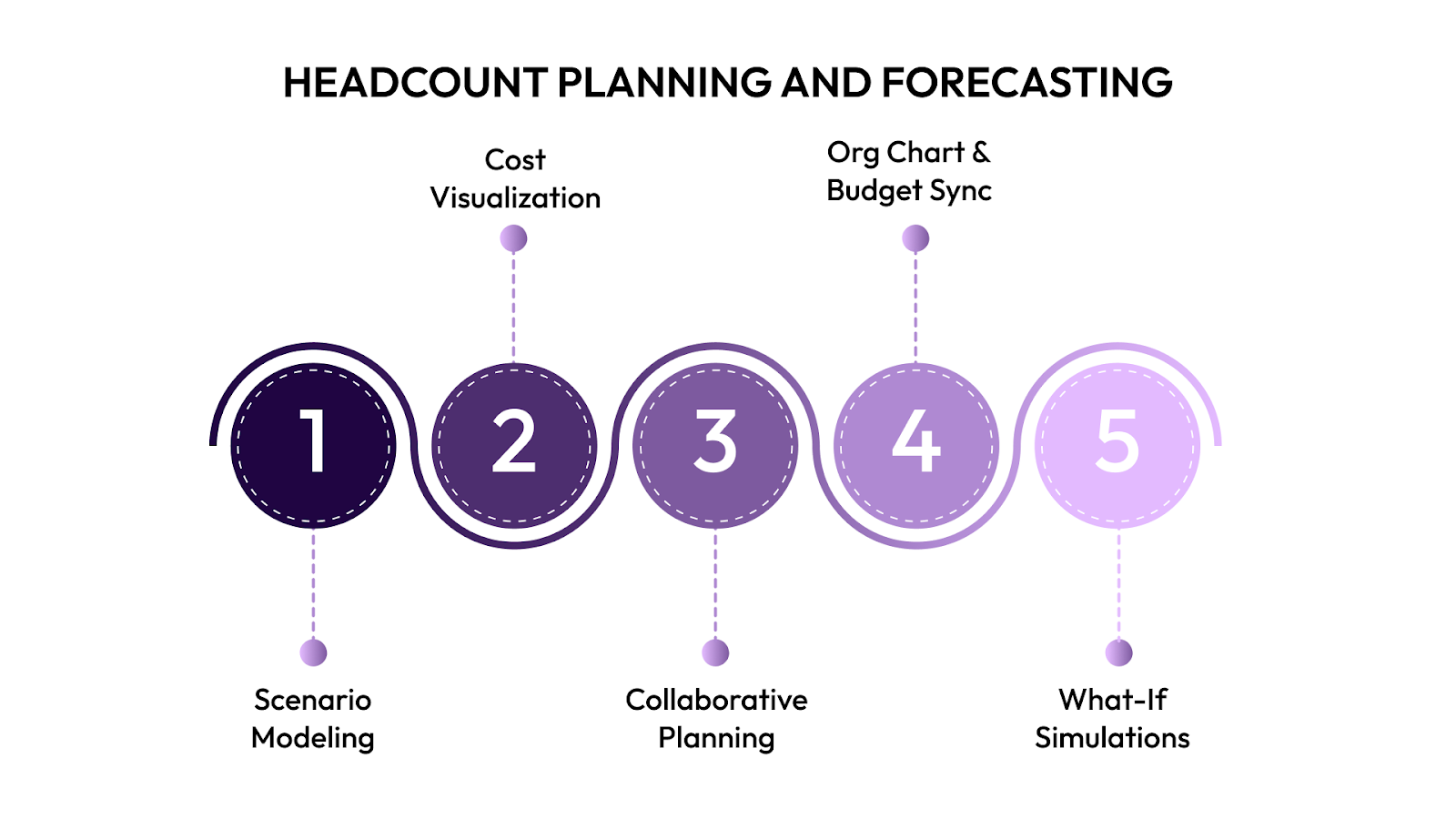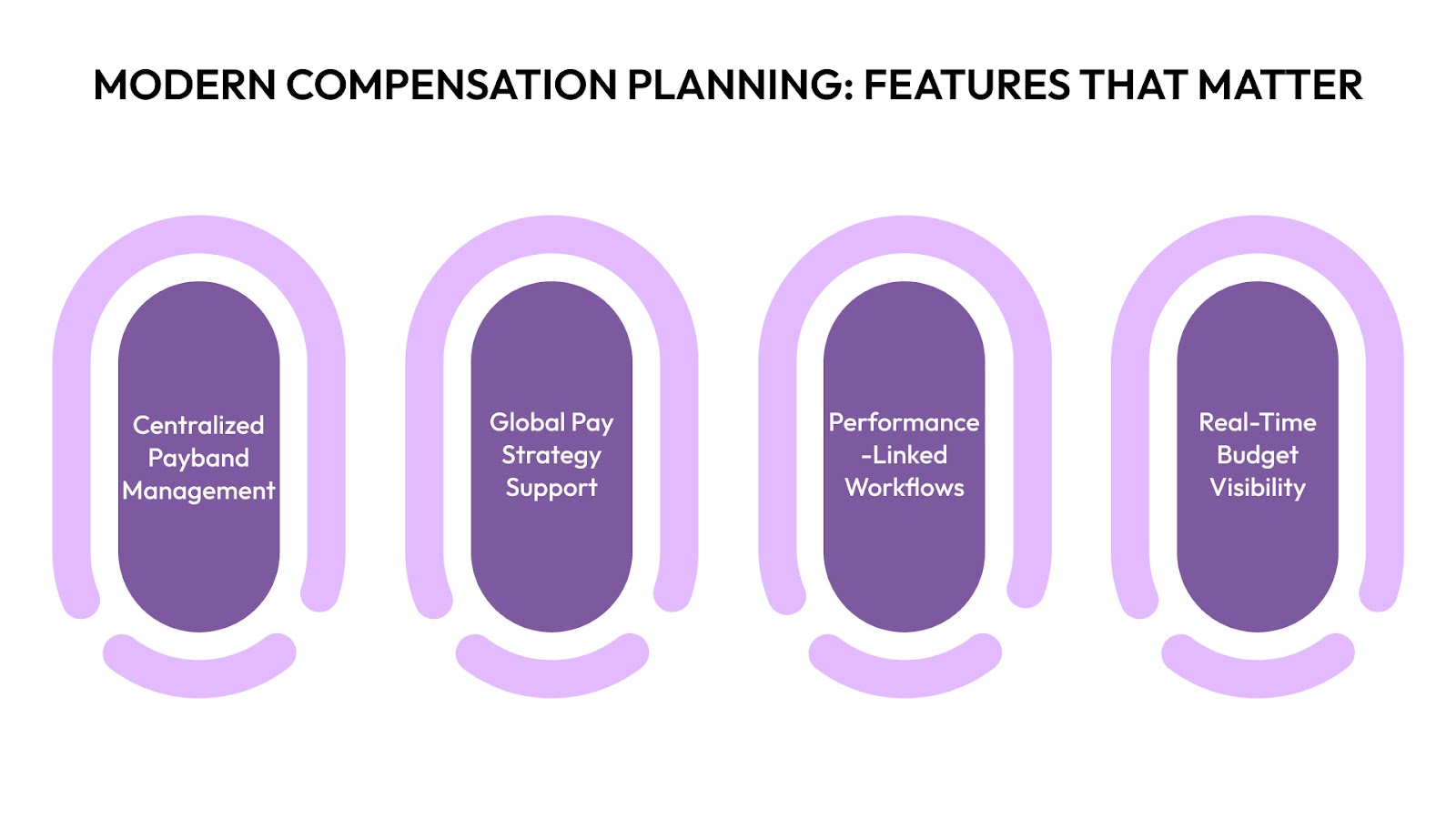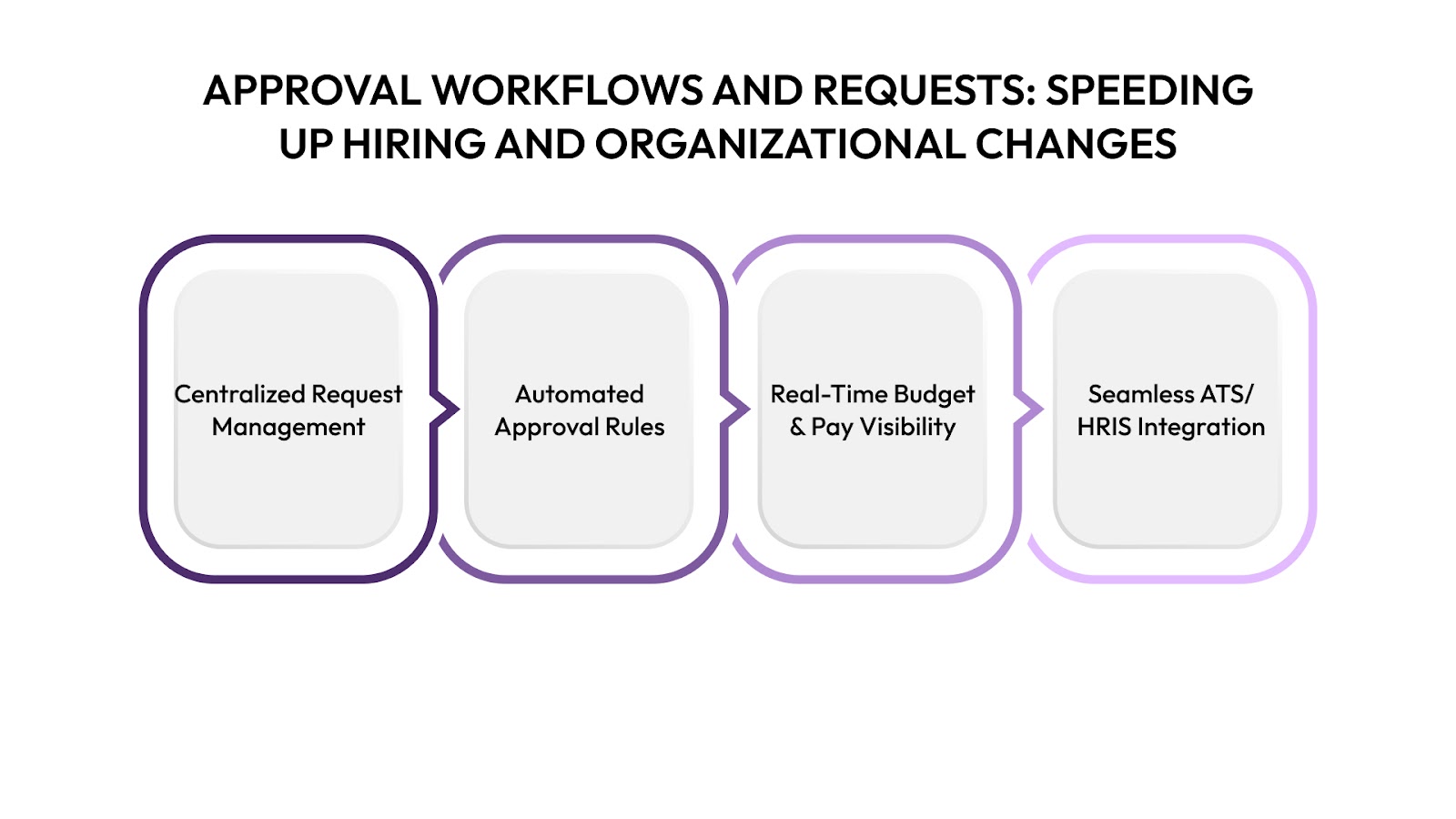A Comprehensive Guide to Top HRMS Solutions
Explore top HRMS solutions for 2025. Compare features, ROI, and tools to find the best fit for your growing team's payroll and planning needs.

High-growth companies in SaaS, fintech, e-commerce, and professional services face mounting people ops challenges. You need faster, more reliable ways to manage hiring, compensation, and headcount planning. Modern HRMS solutions help by centralizing workforce data and automating admin tasks, freeing up HR and Finance to focus on strategic work.
Cloud adoption is on the rise, with 74% of companies now utilizing cloud-based HR tools. Yet, HR teams remain stretched, with 57% operating at or above capacity, and a similar percentage of time is lost to administrative work.
These facts mean you can’t afford disconnected spreadsheets. The right HRMS solution ties people and finances together, so your CPOs, CFO/FP&A leaders, HRBPs, and recruiting managers can collaborate on realistic headcount plans and competitive compensation.
This guide explores how to choose the right HRMS platform, what to prioritize, and how tools like CandorIQ improve compensation, planning, and collaboration.
Key Features of Modern HRMS Solutions
A well-built HRMS should cover four essential areas: headcount planning, compensation, analytics, and collaboration. Each feature area benefits different stakeholders: HRBPs and people ops gain efficiency, CFOs achieve budget accuracy, and recruiting managers experience speed.
Below, we explore how modern platforms address each of these, along with what to look out for when evaluating solutions.
Headcount Planning and Forecasting

Modern HRMS platforms allow you to move beyond static headcount reports and into dynamic, strategic forecasting.
- Scenario Modeling: Simulate hiring, backfills, promotions, and restructuring before approval to ensure optimal outcomes. This helps align people's decisions with revenue projections and cost constraints, providing a more effective allocation of resources.
- Cost Visualization: Modern HRMS platforms calculate fully loaded costs, encompassing salaries, taxes, and benefits, enabling you to assess the financial impact of each hire.
- Collaborative Planning: Stakeholders across HR, FP&A, and leadership can review, comment on, and approve plans in-platform, streamlining the decision-making process.
- Org Chart & Budget Sync: Visual org charts update instantly as you adjust headcount, showing how changes affect budgets across departments.
- What-If Simulations: Build and compare multiple hiring scenarios by function or location to determine the most cost-effective and scalable path forward.
Companies using cloud-based HRMS report up to a 50% reduction in time-to-hire and faster budget alignment through shared, scenario-based planning workflows.
Looking for faster, finance-aligned workforce planning? CandorIQ’s headcount planning module enables you to simulate cost scenarios, track organizational changes, and obtain cross-functional signoff, all in one place.
After understanding the foundational features, it’s essential to explore how compensation planning drives fairness and financial control.
Also Read: The Ultimate Guide to Headcount Analysis and Workforce Planning
Modern Compensation Planning: Features That Matter

Modern HRMS solutions must provide transparent, data-driven, and globally consistent compensation planning. From setting pay bands to managing merit cycles, every component should support equity, accountability, and budget alignment.
Here are some key features:
1. Centralized Payband Management
All pay ranges and job levels should be housed in a unified system. This eliminates spreadsheet sprawl and ensures consistency across departments and geographies.
- Unified job architecture allows HR teams to build and manage pay bands for every role and level.
- Role-based permissions ensure that only authorized users can edit or update ranges.
- Managers should be able to leave contextual notes for decisions on pay band placements.
2. Global Pay Strategy Support
Modern systems need to handle multi-region operations with ease.
- Adjust compensation by geography and account for local market benchmarks.
- Track pay compression risks and benchmark pay against real-time data.
- Tailor compensation frameworks per country or region to maintain competitiveness and equity.
3. Performance-Linked Workflows
Compensation planning must integrate seamlessly with performance management tools.
- Merit increases and bonuses should be automated based on performance review data and business rules.
- AI-driven tools can enhance transparency and reduce bias in compensation cycles (e.g., “AI Cycle” tools seen in some platforms).
4. Real-Time Budget Visibility
Finance and HR teams need visibility into total compensation costs.
- Systems should display how offers, raises, and bonuses impact budgets in real-time.
- This alignment helps ensure compliance with headcount targets and financial caps.

Why It Matters?
According to the Bureau of Labor Statistics, wages and salaries account for approximately 70% of total labor costs in private industry. This makes compensation one of the most significant levers for financial sustainability, talent retention, and organizational equity.
Modern platforms are evolving to help HR and finance teams manage this complexity:
- ADP Workforce Now supports basic compensation planning, where budgets are tied to performance reviews, and raises and bonuses can be automated. However, it may lack deeper analytics or global customization.
Adequate compensation relies on real-time insights. Now, let’s examine how workforce analytics transforms data into smarter pay and staffing decisions.
Also read: Compensation Management Software Guide for HR Teams in 2025
Workforce Analytics and Reporting: Actionable Insights at Your Fingertips
A powerful HRMS should do more than record employee data. It should help you make fast, informed decisions. With built-in analytics and real-time dashboards, you can detect patterns, forecast needs, and align workforce strategy with financial goals.
Here’s what you need to look for in modern workforce analytics:
1. AI-Driven Workforce Intelligence
Advanced HRMS platforms now embed AI to surface hidden trends within your workforce.
- Predictive analytics helps identify churn risks by analyzing factors such as tenure, performance, compensation, and team dynamics.
- AI engines can flag anomalies, such as outlier salaries or uneven compensation across similar roles.
- Some platforms even recommend pay adjustments or role restructuring based on internal patterns and external benchmarks.
2. Dynamic Budget Forecasting
Forecasting tools enable HR and finance teams to simulate hiring and compensation scenarios in real time.
- You can model how hiring more engineers versus sales reps would affect payroll, budget allocation, and revenue targets.
- These simulations help build flexible workforce strategies that respond to changing business goals.
3. Benchmarking Against Market Trends
Your analytics platform should allow you to compare internal metrics against industry standards.
- Tools like ADP’s DataCloud let you run machine-learning reports across payroll, HR, and benefits data.
- You can evaluate attrition rates, hiring velocity, and diversity metrics against market averages to identify areas where you are lagging or excelling.
- This benchmarking helps identify gaps in pay equity, talent retention, and workforce productivity.
4. Real-Time Reporting Dashboards
Modern HRMS dashboards update instantly as soon as data changes—no waiting for end-of-month reports.
- Dashboards consolidate key metrics like headcount, salary changes, bonus allocations, and performance distributions.
- This ensures leaders make decisions using the most current data available.
- According to Market Reports World, 54% of HR leaders rely on analytics for staffing, compensation planning, and workforce optimization.
For recruiting managers and HR Business Partners (HRBPs), CandorIQ eliminates last-minute surprises regarding headcount or budget. Its analytics integrate seamlessly with planning tools, letting you drill down from company-wide trends to individual teams.
Analytics inform strategy, but approvals turn plans into action. The next step is streamlining the process for hiring and approving changes.
Approval Workflows and Requests: Speeding Up Hiring and Organizational Changes

Slow or unclear approval processes can delay critical hires and stall growth. A modern HRMS should streamline these workflows to ensure managers, recruiters, and finance teams stay aligned from request to hire. Let’s look at the key capabilities:
1. Centralized Request Management
All new position and backfill requests should route through a unified platform with complete visibility at every step.
- A centralized system eliminates the need for scattered emails or offline approvals.
- Org chart views help track request status and identify bottlenecks in real time.
2. Automated Approval Rules
Routine approvals, such as backfilling a recently vacated role, should be handled automatically based on predefined rules.
- This speeds up hiring for critical roles without compromising on policy or budget oversight.
- Recruiters can begin sourcing candidates immediately once auto-approvals are triggered.
3. Real-Time Budget and Pay Visibility
Managers should have access to relevant pay bands and department budgets when submitting a request.
- This helps avoid over-budget hiring and keeps compensation aligned with internal benchmarks.
- Built-in financial guardrails reduce the risk of non-compliant approvals.
4. Seamless ATS/HRIS Integration
Approval tools should integrate with your existing recruiting and HR systems.
- This ensures bi-directional data flow between applicant tracking systems, HRIS platforms, and planning dashboards.
- Hiring teams get updated headcount visibility without manual data entry.
Why It Matters?
By streamlining hiring requests and automating routine approvals, companies can significantly increase hiring velocity and reduce administrative overhead. For example:
- ADP Workforce Now supports basic approval chains but often requires custom configuration to align with an organization's structure.
- Workday offers robust, multi-layered approvals; however, the initial setup can be complex and time-intensive.
The right HRMS automates the most common approval steps, maintains transparency, and accelerates headcount decisions, ideal for fast-moving, high-growth teams.
Now that you’ve seen what matters functionally, it’s time to compare how top HRMS platforms deliver on those capabilities.
Comparing Leading HRMS Platforms
Choosing the right HRMS means weighing your company’s size, priorities, and growth plans. Here’s a quick comparison of four popular HR platforms suitable for mid-sized U.S. businesses (50–5,000 employees), followed by a deeper breakdown of each.
Platform Breakdowns
While the comparison table provides a snapshot, each platform offers distinct strengths, depending on your needs, whether it's payroll, compensation, or planning. Below is a detailed examination of how each HRMS solution addresses various use cases and business priorities.
1. CandorIQ – Unified Headcount, Compensation & Analytics
CandorIQ is built for fast-growing tech and service firms. It combines headcount planning, compensation management, and analytics into a single platform. Ideal for orgs needing HR-Finance alignment.
- Strengths: Real-time scenario modeling, collaborative merit and approval workflows, global pay management.
- AI & Analytics: Flags churn risks, forecasts budget impact of hiring, and suggests comp adjustments.
- Considerations: Newer to the market but trusted by 300+ firms; integrates with 100+ payroll/HR systems.
2. Workday HCM – Enterprise-Grade Workforce Management
Workday is a cloud-native HR and finance suite built for scale. It unifies HR and financial planning, making it a popular choice for Fortune 500 firms. Workday’s interface is modern and responsive, and its deep customization options suit complex organizations.
- Strengths: Highly customizable, scalable across global entities, powerful reporting, and workforce planning.
- Payroll: Integrates with global payroll providers to pay in 100+ countries; supports contractors and compliance-heavy setups.
- Compensation: Advanced tools including AI-based suggestions, equity planning, and merit cycle automation.
- Considerations: Implementation is resource-intensive and may take several months; it is best suited for firms with strong IT support.
3. ADP Workforce Now – Payroll and Core HR Powerhouse
ADP excels in payroll automation and compliance. Workforce Now is tailored for businesses with 50–1,000+ employees and includes benefits management, time tracking, and core HR.
- Strengths: Fast deployment, excellent payroll accuracy, and compliance assurance.
- Payroll: Covers 140+ countries with ADP Global Payroll.
- Compensation: Links performance reviews to compensation decisions and automates the process of raises and bonuses.
- Considerations: The UI may feel dated; there is less focus on headcount planning and collaboration.
Making the Right Choice for Your Team
Selecting the right HRMS depends on your company’s structure, growth stage, and core operational priorities. To make the best decision, focus on what matters most: workforce agility, budget alignment, ease of implementation, and user adoption. Involving HR, finance, and business managers early ensures all functional needs are addressed.
For example:
- If global payroll and compliance are key, ADP’s fast deployment and automation tools are a strong fit.
- If you’re managing a complex, multinational org, Workday’s scalability and deep customization may justify the longer implementation time.
- If you’re growing quickly and need agile planning and execution, a more intuitive, specialized platform may be a better choice.
What to Prioritize in Your Evaluation?
Choosing the right HRMS isn’t just about features. To make a confident decision, do consider the following factors:
1. Integration with Existing Systems:
Ensure the HRMS can seamlessly connect with your core tools—payroll, accounting, ATS, and workforce planning platforms. Broad integration reduces manual data entry and improves cross-functional reporting.
2. Implementation Timeline: Deployment times vary widely.
- Platforms like ADP often go live in weeks.
- Enterprise suites, such as Workday, can take several months to implement and require extensive IT support.
- Plan for user training, testing, and change management during rollout.
3. User Experience and Accessibility: User adoption hinges on a clean interface and mobile accessibility.
- According to reviews from OutSail HR, platforms like Workday and UKG offer polished user interfaces (UIs) for employee-facing tasks.
- Simpler tools are often better suited for mid-sized teams without dedicated IT resources.
4. Cost and Return on Investment (ROI): Think beyond license fees. Evaluate the total impact on your hiring, payroll, and compensation workflows
- A well-implemented HRMS can reduce payroll errors, accelerate hiring by up to 50%, and optimize headcount planning and management.
- For example, mid-market companies using platforms like CandorIQ have reported annual savings of over $ 500,000 by streamlining compensation cycles and aligning headcount with budgets in real-time.
Also read: How AI is Changing HR: Managing Compensation, Salary Ranges, and Merit Cycles

Wrapping Up
By carefully assessing your people and finance goals against each platform’s strengths, you’ll pick an HRMS that grows with you. As a CFO or People Ops leader, you want precise data and quick decisions. As a CPO or HRBP, you want engagement and fairness. CandorIQ is built to align those needs; it links headcount and comp planning under AI-driven insights, so HR and Finance speak the same language.
Take the next step and schedule a demo to explore how you can streamline headcount planning, automate compensation cycles, and empower your teams with real-time analytics. Empower your HR and Finance leaders with a system that keeps everyone aligned and your budgets on track.
Connect with us today!


